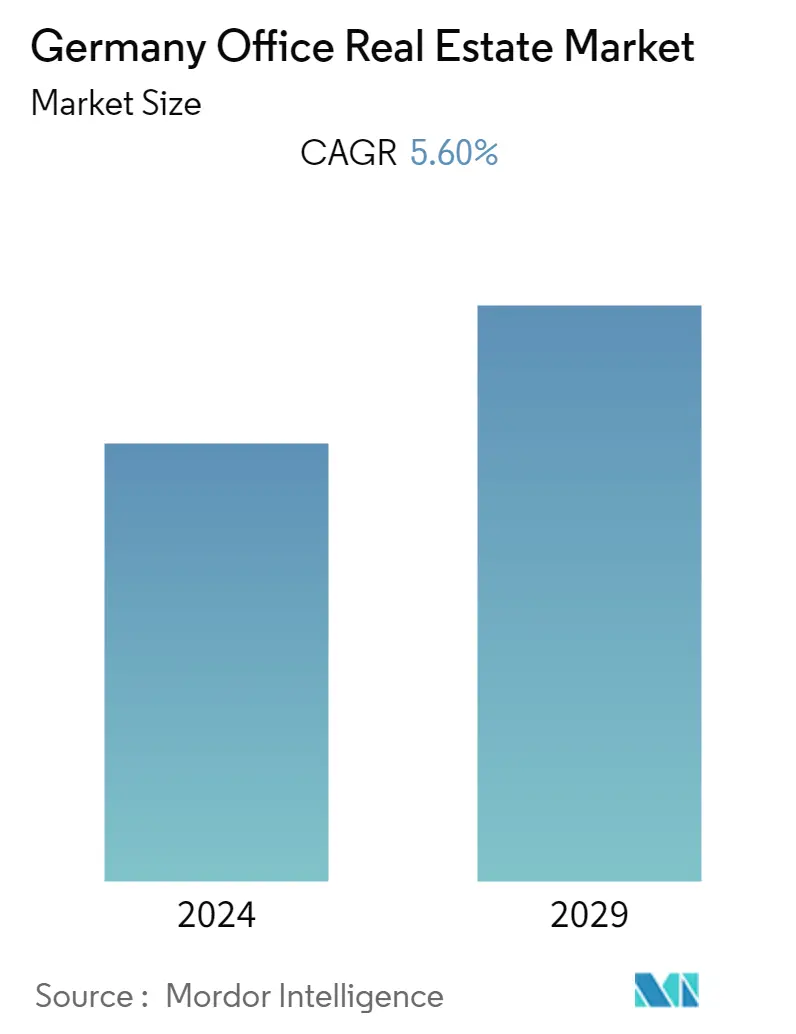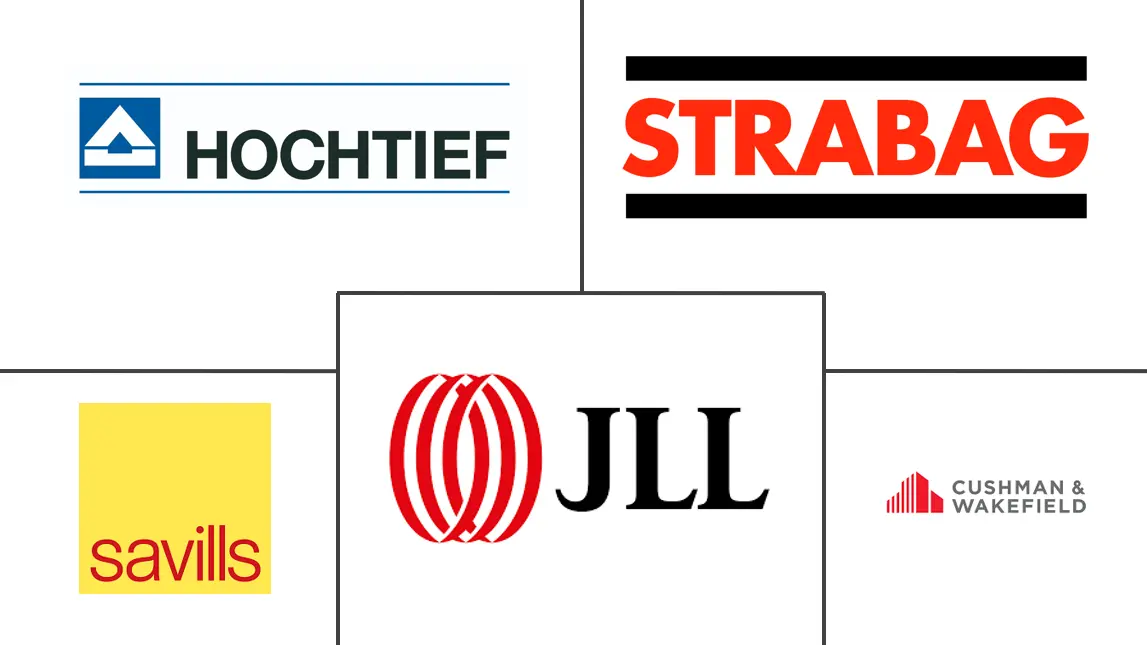Market Size of Germany Office Real Estate Industry

| Study Period | 2020 - 2029 |
| Base Year For Estimation | 2023 |
| Forecast Data Period | 2024 - 2029 |
| Historical Data Period | 2020 - 2022 |
| CAGR | 5.60 % |
| Market Concentration | Medium |
Major Players
*Disclaimer: Major Players sorted in no particular order |
Germany Office Real Estate Market Analysis
- The German office real estate market is expected to record a CAGR of over 5.6% during the forecast period, 2022-2027. Due to restrictions, social distancing policies, and a work-from-home culture, the COVID-19 pandemic significantly impacted Germany's office real estate market, working habits, and locations. Due to the pandemic, the majority of businesses have implemented remote working. Exogenous shocks like the conflict in Ukraine, soaring inflation, and supply constraints are stifling the German economy. These factors have made economic activity considerably less than anticipated at the start of the year.
- However, the office market fared well in the third quarter of 2022 due to a balance between uncertainty and strong fundamentals. The big cities took up slightly under 2.8 million sq. m of office space in the first nine months of 2022, a 29% rise from the same period in 2021. This is where the current problem does seem a little different, especially given the rise in take-up in all of the Big 7 office strongholds. In Düsseldorf, it's just under 7%, but in Stuttgart, it's 200%.
- As the market for new-build space is still very competitive, making it difficult to pre-let space, and because there is growing pressure to get rid of outdated premises, many occupiers, particularly larger corporates, are currently moving forward with planned moves and new leases by up to two years.
- Most businesses are looking for office space with excellent standards to recruit and keep employees. An appealing workplace environment increasingly influences a company's business performance. About 43% of businesses intend to increase investment in a sustainable and flexible workplace between now and 2025, according to a recent JLL survey.
- Trends also suggest that much larger sums of money must be spent in existing stock to meet market demand and account for a drop in new construction activity, which can be profitable because most businesses are still prepared to pay a higher rental rate for a property that has been renovated sustainably and complies with ESG standards. Estimates indicate that by 2030, over one-fifth of all German office space will no longer adhere to European ESG requirements, demonstrating the urgent necessity for proactive solutions.
- Companies looking for office space have a total of roughly 4.6 million sq. m of short-term options in the big real estate powerhouses. However, vacancy rates will likely steadily increase, especially for lower-grade office space. The use of premium space makes up over 70% of the total office space. Unoccupied space caused by relocation that does not fit the needs of new tenants tends to stay vacant. This area can only be advertised due to large rental price reductions or after extensive renovations.
Germany Office Real Estate Industry Segmentation
Office real estate is the construction of buildings for leasing and selling purposes to companies from different sectors. This report aims to provide a detailed analysis of the office real estate market. It focuses on the market insights, dynamics, technological trends, and government initiatives.
The German Office Real Estate Market is Segmented by Key Cities (Berlin, Hamburg, Munich, Cologne, and Other Cities). The report offers market size and forecast in value (USD billion) for all the above segments.
| By Key Cities | |
| Berlin | |
| Hamburg | |
| Munich | |
| Cologne | |
| Other Cities |
Germany Office Real Estate Market Size Summary
The German office real estate market is navigating a complex landscape shaped by the aftermath of the COVID-19 pandemic, which accelerated remote working trends and altered demand for office spaces. Despite challenges such as the Ukraine conflict, inflation, and supply constraints, the market showed resilience in major cities, with significant uptake in office space. The competitive nature of new-build spaces and the need to phase out outdated premises have prompted many corporations to expedite their relocation and leasing plans. Companies are increasingly prioritizing high-standard office environments to attract and retain talent, with a notable shift towards investing in sustainable and flexible workspaces. This trend is driven by the recognition that an appealing workplace can significantly impact business performance.
The market is also witnessing a shift in lease structures, with indexation and rental escalation clauses becoming prevalent to mitigate inflation risks. These clauses provide landlords with value protection while offering tenants some security against future rent increases. Demand remains robust, particularly for premium office spaces, although vacancy rates are expected to rise for lower-grade properties. The need for substantial investment in existing office stock is underscored by the anticipated non-compliance of a significant portion of Germany's office spaces with European ESG standards by 2030. Major players in the market, such as Savills, JLL, and Cushman & Wakefield, continue to influence the sector, with strategic investments and expansions reflecting ongoing market dynamics.
Germany Office Real Estate Market Size - Table of Contents
-
1. MARKET INSIGHTS AND DYNAMICS
-
1.1 Market Overview
-
1.2 Market Dynamics
-
1.2.1 Market Drivers
-
1.2.2 Market Restraints
-
1.2.3 Market Opportunities
-
-
1.3 Industry Attractiveness - Porter's Five Forces Analysis
-
1.4 Industry Value Chain Analysis
-
1.5 Technological Innovations in the Office Real Estate Market
-
1.6 Government Regulations and Initiatives in the Industry
-
1.7 Insights into Rental Yields in the Office Real Estate Segment
-
1.8 Insights into the Key Office Real Estate Industry Metrics (Supply, Rentals, Prices, Occupancy/Vacancy (%))
-
1.9 Insights into Office Real Estate Construction Costs
-
1.10 Insights into Office Real Estate Investment
-
1.11 Impact of the COVID-19 on the Market
-
-
2. MARKET SEGMENTATION
-
2.1 By Key Cities
-
2.1.1 Berlin
-
2.1.2 Hamburg
-
2.1.3 Munich
-
2.1.4 Cologne
-
2.1.5 Other Cities
-
-
Germany Office Real Estate Market Size FAQs
What is the current Germany Office Real Estate Market size?
The Germany Office Real Estate Market is projected to register a CAGR of 5.60% during the forecast period (2024-2029)
Who are the key players in Germany Office Real Estate Market?
Savills, JLL, Cushman & Wakefield, STRABAG and BAUER Group are the major companies operating in the Germany Office Real Estate Market.

